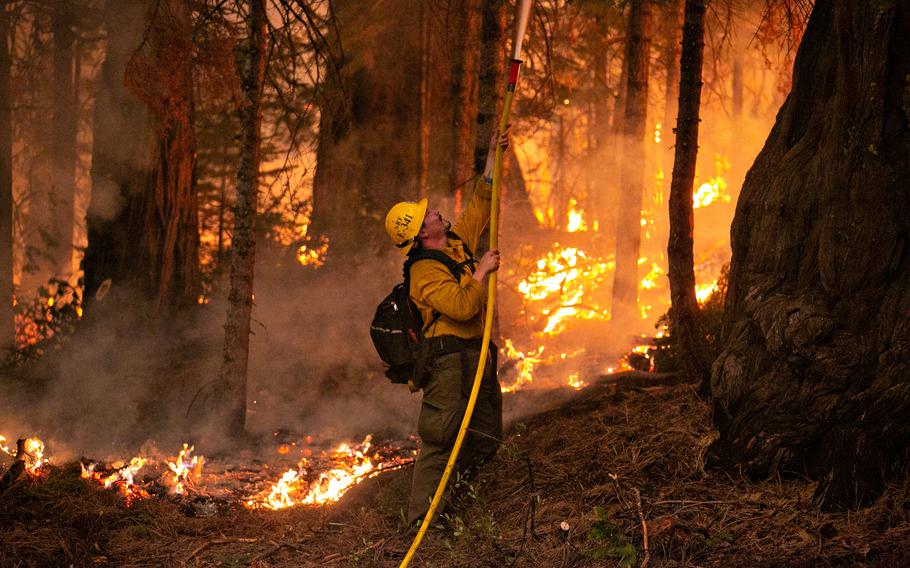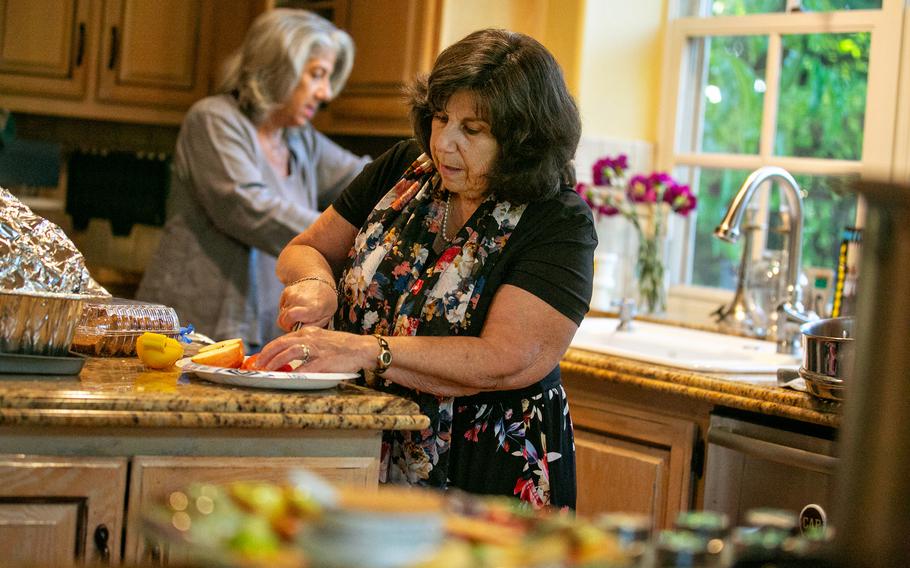
A firefighter works a control burn to head off a spot fire that started on a ridge behind a business on Highway 50 on August 28, 2021, in Strawberry, Calif. (Jason Armond/Los Angeles Times/TNS)
PLACERVILLE, Calif. (Tribune News Service) — This is how you ring in the Jewish New Year in the middle of a wildfire.
The rabbi still wears white, a symbol of purity and new beginnings, but instead of reading the Torah from the bimah, the synagogue's stage, he stands in an Airbnb in Santa Rosa, Calif., — his wife and children in the other room.
The actual synagogue, the center of Jewish life, is empty, and the winding mountain roads that lead to its doors are closed, patrolled by police and fire officials and sometimes the National Guard.
The Torah scrolls are not in their usual home, called an ark, nor are they with the rabbi in Santa Rosa. They have been evacuated from the temple and are resting in the empty upstairs bedroom of a congregant in Nevada, covered by a traditional white and blue tallit, or prayer shawl.
On Monday, congregants from three temples once near the path of the Caldor fire logged into Rosh Hashanah services on Zoom.
"We welcome this new year with renewed sense of resilience because we know that's what's called of us," intoned Rabbi Evon Yakar, 42.
Last month, the Caldor fire roared through Pollock Pines, displacing members of one congregation. Then, in the final days of the month — and the Hebrew calendar year — intense winds pushed the blaze toward the Lake Tahoe Basin, threatening to raze the homes of another.
On Aug. 30, thousands of people were forced to evacuate South Lake Tahoe, including many of the 65 families that make up Temple Bat Yam.
The events of the following week tested the region's small, dispersed Jewish communities, which started merging when Yakar, previously the rabbi at South Lake Tahoe's Temple Bat Yam, became the spiritual leader of the North Tahoe Hebrew Congregation.
When the COVID-19 pandemic halted religious gatherings statewide and the Tahoe congregations moved Shabbat services online, a third temple, Temple Or Rishon in the eastern Sacramento Valley, joined them.
Then the Caldor fire threatened to breach Echo Summit and rush toward Temple Bat Yam, days before Rosh Hashanah, when Jews begin to ask God for two things.
Forgiveness. And life.
Pamela Taylor, who has lived in South Lake Tahoe for three decades, was ready to evacuate mid-August, when she noticed ash from another blaze, the Tamarack fire, raining down from the sky into her lunch.

Pamela Taylor, an evacuee of the Caldor fire in South Lake Tahoe, prepares apples and honey for the Jewish New Year in Calabasas, Calif. (Jason Armond/Los Angeles Times/TNS)
By Aug. 26, the Caldor fire, which began explosively in the densely forested area south of Pollock Pines, had burned 136,000 acres and turned the air noxious.
Taylor herded her blind, insulin-dependent dog into her red Subaru the following day. She packed her daughters' birth certificates, her marriage license, home insurance documents and family vaccination cards, and made her exodus.
As she drove the 500 miles toward her daughter's home in the San Fernando Valley, the approaching new year weighed heavily on her.
One of the Jewish peoples' holiest holidays, Rosh Hashanah marks a 10-day period of reflection and repentance leading into Yom Kippur, when, Jews believe, God inscribes names into — and seals — the book of life.
Winding down Highway 395, Taylor worried for her town and Temple Bat Yam, where she'd made a home for herself after moving from the Valley to South Lake Tahoe in 1991.
But she worried especially for her husband of 35 years, Chris, who stayed behind to care for his 91-year-old father.
"You think about what we say from year to year," Taylor said, tearing up on the first evening of Rosh Hashanah. "Who shall live and who shall die? Who shall be consumed in fire?"
Rabbi Yakar also fled South Lake Tahoe when it became too dangerous to breathe.
On Aug. 29, Yakar watched from his Airbnb in Santa Rosa as a monstrous glow of fire rose over Echo Summit, threatening the small, wooded towns of Christmas Valley and Meyers, and just below them, Temple Bat Yam. The converted-parish backed into U.S. Forest Service land.
The rabbi worried about his close friends fighting the fire and for his neighbors trapped without cars; for the people who probably couldn't afford a hotel room even if they escaped. For a temple member in Christmas Valley with severe hearing loss and another evacuated while hospitalized with COVID-19.
He also worried for the temple's two Torah scrolls — one handwritten for the Temple Bat Yam congregation, the other a Holocaust scroll, which survived the Nazis' public bonfires of holy Jewish books.
Yakar asked congregants Charna and Allen Silver to drive into the smoldering landscape and evacuate the Torahs from Temple Bat Yam. They did.
Former Temple Bat Yam President John Kuzmik drove through the smoke to the Silvers' home and evacuated the holy scrolls a second time.
With the fires still raging around South Lake Tahoe and the fate of his own home still in jeopardy, Kuzmik didn't know if he and his wife would be evacuated next. "One thing we knew for sure," he said, "is that the Torahs would go with us wherever we went."
As the fire loomed over Temple Bat Yam, the congregants' across-the-lake neighbors at the North Tahoe Hebrew Congregation and Temple Or Rishon in the eastern Sacramento valley got busy.
On Aug. 27, Mary Frank, the education and communications director who earned the nickname "the magician" for her logistical prowess during the catastrophe, sent a survey to every member of the Temple Or Rishon congregation, the largest of the three. She asked who had space in their homes for evacuees or resources they could spare.
Dozens did, including Tim Herman, a dentist in Roseville, and his wife, Pam, who offered to put up a Temple Bat Yam family in their second home, in Truckee, 40 miles north of the flames.
As Frank connected Taylor with the Hermans, she learned that the evacuee's father-in-law required a special chair to sleep. She immediately called a Rent-A-Center in Reno and secured a black power recliner at a cost of $135 for four weeks.
A day and a half later, Chris Taylor drove his father from a hotel to the Hermans' home. Relief washed over him.
Monday evening, warm choral music welcomed the congregants as they trickled in for Rosh Hashanah services.
"L'shanah tovah tikatevu," the Temple Or Rishon cantor sang from a bright bimah. May you be inscribed and sealed for a good year.
Yakar began with a greeting familiar to those who had spent the last 18 months logging into religious services online.
"I think we're all too familiar with 'the Zoom,' but remember," he said, his eyes smiling. "Stay muted unless you have a reason to be unmuted — and you know who you are."
Hundreds of men, women and children huddled on couches and in kitchens in far-flung corners of California. Families who had been evacuated by the fire a week earlier sat beside those who offered them shelter.
Alexis Wagner, 62, known affectionately to the community as "Bubbe Alexis," for her proclivity for feeding others, logged in from her daughter's apartment in Napa. With her were the few things she grabbed from her Tahoe home before she fled the fire — including a pair of plain brass Shabbat candlesticks that had belonged to her grandmother.
Caroline Matera, 63, and Richard Matera, 54, sat in their home in South Lake Tahoe, having returned that morning, exhausted. When the blaze drew near, the couple first evacuated to Mammoth. But days later, eager to serve, they drove across the Nevada state line and spent the week volunteering with the Red Cross at a Reno evacuation center.
To close out the service, Temple Or Rishon's Rabbi Alan Rabishaw shared a final blessing. Hours before, mandatory evacuation orders had been lifted and South Lake Tahoe residents would begin their trip back home.
"Bruchim haba'im. Be welcome. Be secure."
"Know that your walls are there to keep you safe," Rabishaw said, "and if the walls can't keep you safe, you have community around you, on top of the hill and down the hill, who love you and embrace you, as we know you would do for us."
___
©2021 Los Angeles Times.
Visit at latimes.com.
Distributed by Tribune Content Agency, LLC.